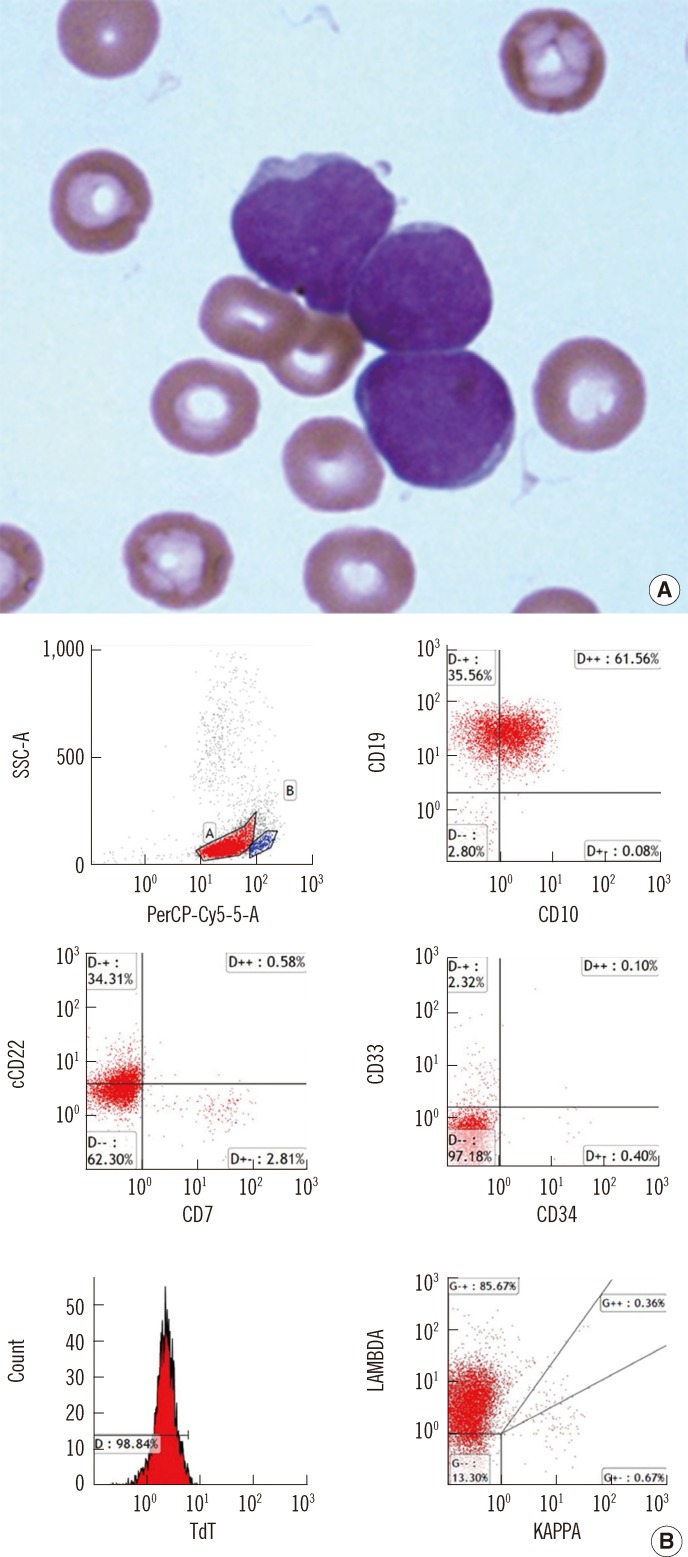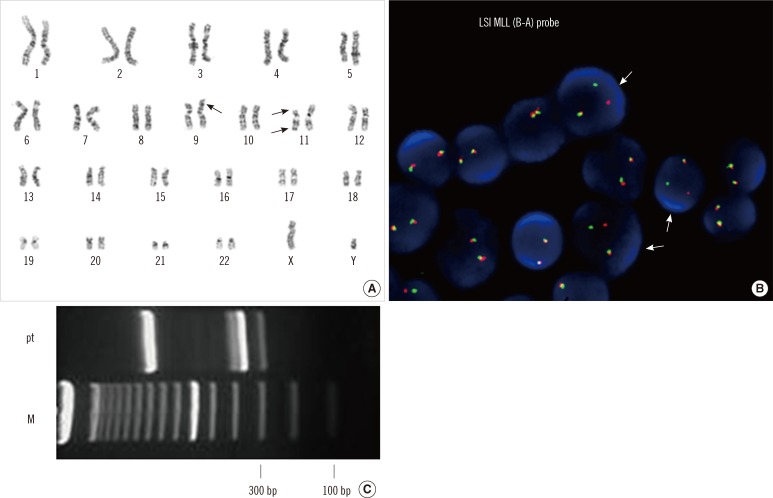Ann Lab Med.
2014 Mar;34(2):166-169. 10.3343/alm.2014.34.2.166.
Acute Lymphoblastic Leukemia with Mature B-Cell Phenotype and t(9;11;11)(p22;q23;p11.2): A Case Study and Literature Review
- Affiliations
-
- 1Department of Laboratory Medicine and Genetics, Samsung Medical Center, Sungkyunkwan University School of Medicine, Seoul, Korea. sunnyhk@smc.samsung.co.kr
- 2Department of Pediatrics, Samsung Medical Center, Sungkyunkwan University School of Medicine, Seoul, Korea.
- KMID: 1791914
- DOI: http://doi.org/10.3343/alm.2014.34.2.166
Abstract
- No abstract available.
MeSH Terms
-
Aged
B-Lymphocytes/*cytology/metabolism
Child
*Chromosomes, Human, Pair 11
*Chromosomes, Human, Pair 9
Female
Humans
Immunophenotyping
Infant
Karyotyping
Male
Myeloid-Lymphoid Leukemia Protein/genetics/metabolism
Oncogene Proteins, Fusion/genetics/metabolism
Precursor Cell Lymphoblastic Leukemia-Lymphoma/*diagnosis
Translocation, Genetic
Oncogene Proteins, Fusion
Myeloid-Lymphoid Leukemia Protein
Figure
Reference
-
1. Pui CH, Frankel LS, Carroll AJ, Raimondi SC, Shuster JJ, Head DR, et al. Clinical characteristics and treatment outcome of childhood acute lymphoblastic leukemia with the t(4;11)(q21;q23): a collaborative study of 40 cases. Blood. 1991; 77:440–447. PMID: 1991161.2. Heerema NA, Sather HN, Ge J, Arthur DC, Hilden JM, Trigg ME, et al. Cytogenetic studies of infant acute lymphoblastic leukemia: poor prognosis of infants with t(4;11) - a report of the Children's Cancer Group. Leukemia. 1999; 13:679–686. PMID: 10374870.
Article3. Pui CH, Kane JR, Crist WM. Biology and treatment of infant leukemias. Leukemia. 1995; 9:762–769. PMID: 7769837.4. Ayton PM, Cleary ML. Molecular mechanisms of leukemogenesis mediated by MLL fusion proteins. Oncogene. 2001; 20:5695–5707. PMID: 11607819.
Article5. Krivtsov AV, Armstrong SA. MLL translocations, histone modifications and leukaemia stem-cell development. Nat Rev Cancer. 2007; 7:823–833. PMID: 17957188.
Article6. Swerdllow SH, Campo E, editors. WHO classification of tumours of haematopoietic and lymphoid tissues in 2008. Lyon: IARC Press;2008. p. 262–264.7. Sullivan MP, Pullen DJ, Crist WM, Brecher M, Ramirez I, Sabio H, et al. Clinical and biological heterogeneity of childhood B cell acute lymphocytic leukemia: implications for clinical trials. Leukemia. 1990; 4:6–11. PMID: 2404163.8. Hammami A, Chan WC, Michels SD, Nassar VH. Mature B-cell acute leukemia: a clinical, morphological, immunological, and cytogenetic study of nine cases. Hematol Pathol. 1991; 5:109–118. PMID: 1960134.9. Vasef MA, Brynes RK, Murata-Collins JL, Arber DA, Medeiros LJ. Surface immunoglobulin light chain-positive acute lymphoblastic leukemia of FAB L1 or L2 type: a report of 6 cases in adults. Am J Clin Pathol. 1998; 110:143–149. PMID: 9704611.10. Lorenzana AN, Rubin CM, Le Beau MM, Nachman J, Connolly P, Subramanian U, et al. Immunoglobulin gene rearrangements in acute lymphoblastic leukemia with the 9;11 translocation. Genes Chromosomes Cancer. 1991; 3:74–77. PMID: 1906342.11. Talmant P, Berger R, Robillard N, Mechineau-Lacroix F, Garand R. Childhood B-cell acute lymphoblastic leukemia with FAB-L1 morphology and a t(9;11) involving the MLL gene. Hematol Cell Ther. 1996; 38:265–268. PMID: 8974790.12. Li S, Lew G. Is B-lineage acute lymphoblastic leukemia with a mature phenotype and l1 morphology a precursor B-lymphoblastic leukemia/lymphoma or Burkitt leukemia/lymphoma? Arch Pathol Lab Med. 2003; 127:1340–1344. PMID: 14521459.
Article13. Frater JL, Batanian JR, O'Connor DM, Grosso LE. Lymphoblastic leukemia with mature B-cell phenotype in infancy. J Pediatr Hematol Oncol. 2004; 26:672–677. PMID: 15454841.
Article14. Kansal R, Deeb G, Barcos M, Wetzler M, Brecher ML, Block AW, et al. Precursor B lymphoblastic leukemia with surface light chain immunoglobulin restriction: a report of 15 patients. Am J Clin Pathol. 2004; 121:512–525. PMID: 15080303.15. Tsao L, Draoua HY, Osunkwo I, Nandula SV, Murty VV, Mansukhani M, et al. Mature B-cell acute lymphoblastic leukemia with t(9;11) translocation: a distinct subset of B-cell acute lymphoblastic leukemia. Mod Pathol. 2004; 17:832–839. PMID: 15098014.
Article16. Blin N, Méchinaud F, Talmant P, Garand R, Boutard P, Dastugue N, et al. Mature B-cell lymphoblastic leukemia with MLL rearrangement: an uncommon and distinct subset of childhood acute leukemia. Leukemia. 2008; 22:1056–1059. PMID: 18007578.
Article17. Huret JL, Dessen P, Bernheim A. An atlas of chromosomes in hematological malignancies. Example: 11q23 and MLL partners. Leukemia. 2001; 15:987–989. PMID: 11417488.18. Meyer C, Schneider B, Jakob S, Strehl S, Attarbaschi A, Schnittger S, et al. The MLL recombinome of acute leukemias. Leukemia. 2006; 20:777–784. PMID: 16511515.
Article19. Super HG, Strissel PL, Sobulo OM, Burian D, Reshmi SC, Roe B, et al. Identification of complex genomic breakpoint junctions in the t(9;11) MLL-AF9 fusion gene in acute leukemia. Genes Chromosomes Cancer. 1997; 20:185–195. PMID: 9331569.
- Full Text Links
- Actions
-
Cited
- CITED
-
- Close
- Share
- Similar articles
-
- A Case of Acute Lymphoblastic Leukemia with Facial Nerve Palsy in Infant
- Pancreatitis Induced by 6-mercaptopurine and 6-thioguanine in Childhood Acute Lymphoblastic Leukemia
- Precursor B-Cell Acute Lymphoblastic Leukemia in Two Patients with a History of Cytotoxic Therapy
- Three-way Translocation of MLL/MLLT3, t(1;9;11)(p34.2;p22;q23), in a Pediatric Case of Acute Myeloid Leukemia
- Acute Monocytic Leukemia with t(11;17)(q23;q21) Involving a Rearrangement of Mixed Lineage Leukemia Gene



